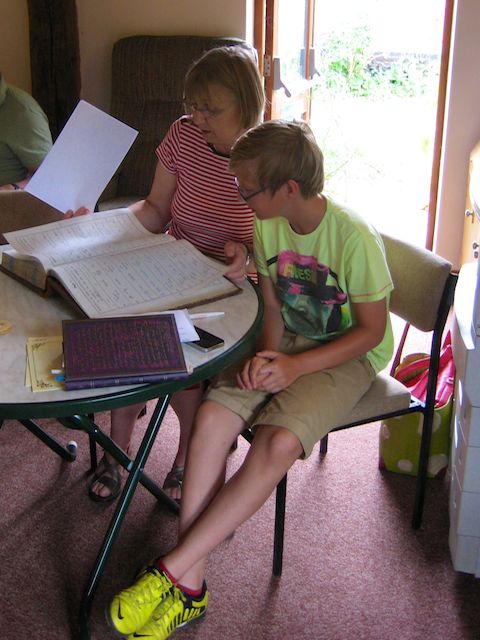Storm proceeded to involve all the participants in practising writing scripts starting with insular half uncial script – examples include The Book of Kells and the Lindisfarne Gospels – moving on to an italic script similar to that used in the early 1900s using the receipt for the previous bell work (written in 1909) as an example. (To see an enlarged image of the receipt click here.)
Monthly Archives: July 2013
Genealogy workshop
On the morning of 20th July a dozen people gathered in the Church Room for our first Family History Workshop. We had decided to make this a beginners’ workshop although some participants had already done some work on their family trees.
Lynn started by explaining that the place to start on a family tree was with oneself – in fact, you cannot sensibly start anywhere else as all subsequent information which you gather is based on your own history. She then went through the various forms of certificates explaining the information which each one contains and discussing the changes in birth and death certificates from a landscape format to a portrait format in 1969 and the extra details which were then required. She also stressed that information may not be absolutely correct – our ancestors have been known to “improve” registrations!
She also pointed out that, when information was transcribed from the original document onto a computer, that step also gave room for errors to be made. Double check everything!
Corinne then discussed the various websites which are available including Ancestry, Genes Reunited and Family Search. She spoke about the masses of information which is available on the Internet, and pointed out that though some sites required taking out a subscription others were free and some of the subscription sites offered, for example, a fourteen day trial period. She finished by warning that family history research is addictive and that she herself had often been found at her computer at two o’clock in the morning still looking for that elusive relative!
Joan then laid out a piece of research done by her into her husband’s family, in particular Thomas Claydon Baldwin. She pointed out that without the middle name of Claydon it would probably have been impossible to track down the correct Thomas Baldwin (many of Thomas’ descendants still carry the name of Claydon as a middle name).
She traced Thomas’ birth and childhood in Essex and through his military career in England, India and Ireland. She discussed his two marriages and the birth of twins – a boy and a girl – in barracks in Ireland and the death of his second wife just a few days after the birth of the babies. She passed round birth, death and marriage certificates, census returns and wills. This was indeed fascinating as it put ‘real’ people into the forefront of research.
After a welcome cup of coffee, everyone settled down to look at some of the photographs, certificates and wills which had been discovered by Corinne, Joan and Lynn during their research.
Those people with local ties were very interested in the Saxlingham Burial Book which dates from 1906 (earlier ones are now deposited with Norfolk County Record Office). Those who wished to borrowed books, general magazines and Lancashire Family History Society magazines to take home.
All in all, everyone enjoyed themselves and we hope we have now encouraged people to start their own family history research!
On 21st September we will hold a second workshop – if you are interested in attending please contact Lynn by emailing info@saxlinghambells.org.uk or by phone. Her number can be found in the Churchwarden’s section of “Contact.”
Talk on Bell-ringing by Simon Rudd
On Thursday 27 June Simon Rudd, the Ringing Master at the Church of St. Peter Mancroft Norwich came along to speak to us about the art of bell-ringing. It was a fascinating talk covering the history of bells and bell founding through the ages. He was ably assisted by Ben, Neil, David and Richard who demonstrated the art of change ringing on a set of handbells. We hope soon to have a video of Simon’s talk on Youtube.
Almost the entire audience of fifty people (which included, I am delighted to say our two youngest trainee bellringers, Alfie and George) then went across to the Church Room for refreshments and an opportunity to talk more about the art of bell-ringing with Simon and his colleagues. Many thanks to them for a most enjoyable evening.
Genealogy and Calligraphy workshops
If you are interested in attending the Genealogy workshop on 20th July or the Calligraphy workshop on 27th July please get in touch asap as places are filling up fast.
Please drop us an email : info@saxlinghambells.org.uk or call Lynn Roberts, Churchwarden on the number in “Contact” – leave a message on the machine if we are out.
Both workshops will be held in the Church Room starting at 10am and finishing around 12.30pm. Refreshments will be available.






